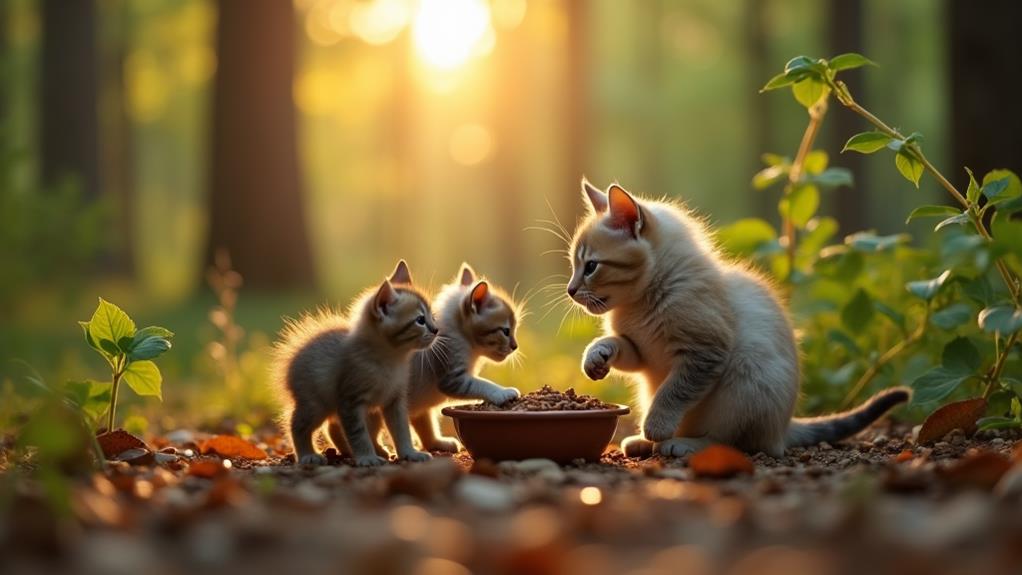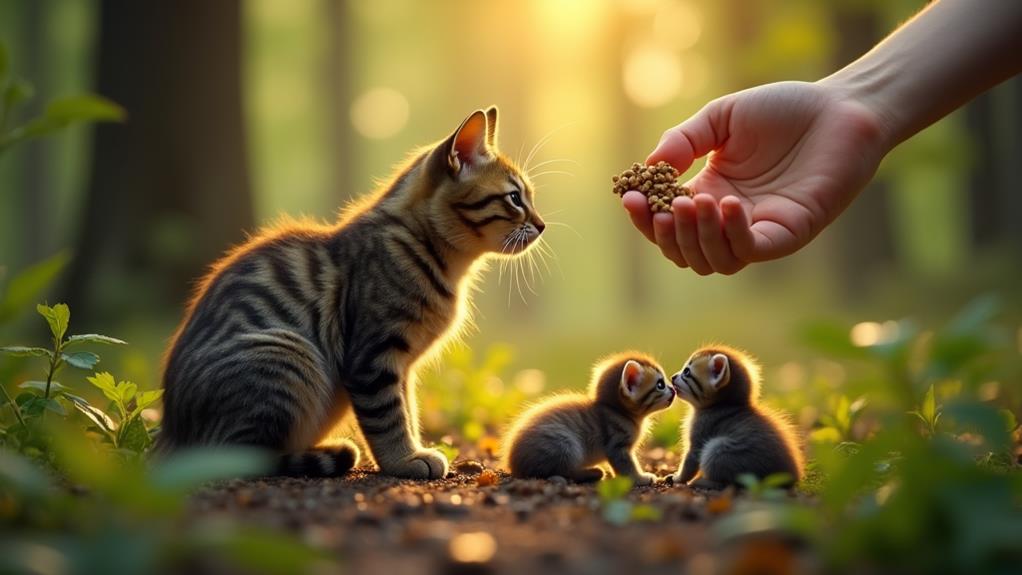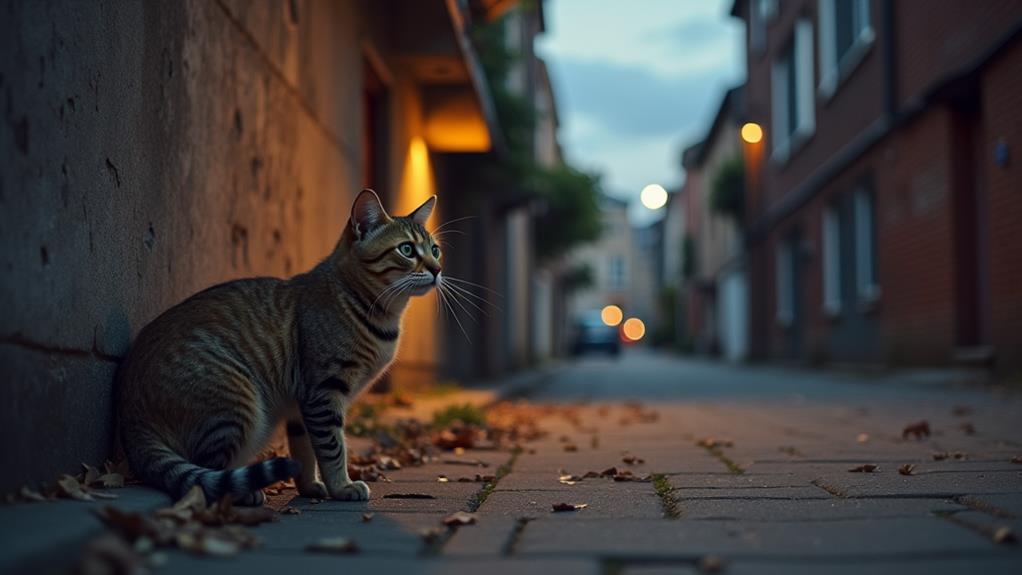When Does a Feral Cat Leave Her Kittens? Understanding Feral Motherhood

You'll find that feral cat mothers typically leave their kittens temporarily to hunt, ensuring they remain safe and fed. From birth, the kittens are vulnerable and depend heavily on their mother for warmth and nourishment. By the time they're about 3-4 weeks old, they'll start exploring, and the mother might move them to safer areas. Weaning happens around 4 weeks, with independence developing by 12 weeks. Although the mother briefly leaves, she stays nearby for protection. Intervention is essential if she's gone too long, especially for kittens under 5 weeks. There's much to uncover about the subtleties of feral motherhood.
Gestation and Nesting
The voyage of feral motherhood begins with gestation, a vital stage lasting about 63-65 days, where the mother cat nurtures her developing kittens. During this time, ensuring high-quality nutrition is fundamental for the mother cat. It directly impacts her health and the proper development of her kittens. Feral mother cats instinctively seek out secluded areas to prepare a nest, providing a safe and warm haven for their soon-to-arrive kittens. The environment must be carefully chosen to minimize threats from predators and harsh weather conditions.
As a feral cat, you'll find that locating these safe spots is indispensable. You'll need to balance between staying hidden and having access to food sources. These nests often become the center of your world as they offer a protective cocoon for your newborns. While your kittens develop, you'll remain vigilant, ensuring their safety and anticipating their needs.
Once your kittens are born, your choice of a nest becomes even more important. You'll frequently check on them, nursing and caring for their needs while occasionally leaving the nest to hunt. This delicate dance continues as you provide the nurturing environment necessary for their early survival.
Early Kitten Development
As your kittens arrive into the world, their voyage of growth and exploration begins. During the initial few weeks, feral mother cats are fundamental to their kittens' survival. Your kittens need their mother to provide nourishment and warmth, as they can't eat solid food or regulate their body temperature. The mother cat only briefly leaves them to hunt, ensuring they have everything they require.
By the time your kittens reach 4 weeks, they're ready to start exploring their surroundings. This is an exciting phase where they initially encounter solid food. You'll notice the mother cat beginning to leave them for longer periods as she hunts, allowing her kittens to become more independent within the safety of their nest. This is also when the socialization stage kicks in, spanning from 4 to 9 weeks. It's significant for your kittens' development, as they learn critical behaviors from their mother and littermates.
During this socialization period, your kittens will gain confidence and important skills through play and interaction. As they observe the mother cat, they pick up on essential survival skills. These early weeks lay the groundwork for their future independence.
Independence Milestones

Independence marks a significant phase in a kitten's life, unfolding with several key milestones. Around 12 weeks of maturity, kittens become more adept at taking care of themselves, thanks to the guidance of feral mother cats. By this time, they're fully weaned, allowing the mother to leave them for longer stretches. This independence doesn't happen overnight; it builds gradually through significant development steps.
Starting as early as 4 weeks, kittens exhibit exploratory behavior, but it's between 5 to 6 weeks that they begin to show early hunting behaviors. This is when they start mimicking their mother's actions, learning how to stalk and pounce, which are vital skills for survival. By 8 weeks, the weaning process is complete, and the kittens rely less on their mother's milk, enabling her to focus on teaching them other necessary skills.
Social skills are another key part of these independence milestones. Kittens learn how to interact with each other and their mother, which helps them understand social cues and establish hierarchies. As they approach 12 weeks of maturity, feral mother cats can leave them more confidently, knowing they've equipped their offspring with vital survival tools.
Maternal Instincts
Many feral mother cats exhibit remarkable maternal instincts that secure their kittens' survival in harsh environments. These instincts drive them to prioritize their kittens' safety and nourishment above all else. You'll notice that feral mother cats typically leave their kittens only briefly to hunt for food or guarantee safety. They often return quickly to nurse and care for them. As the kittens grow, especially after the initial few weeks, the mother might leave more frequently. This isn't neglect; rather, it's part of her natural instinct to provide sustenance and protection.
Around 3 to 4 weeks of maturity, the kittens become more mobile, prompting the mother to possibly relocate them to safer hiding spots. This relocation is a strategic move, fueled by her instinct to shield them from potential threats. Feral mothers usually stay within a 100-foot radius of their kittens, confirming they're always close by to react to any danger. Spaying feral mothers is imperative—not only does it prevent future litters, but it also allows them to focus their energy on the current kittens, reducing the stress of repeated pregnancies and enhancing their ability to nurture their young.
Weaning Off Milk

Initiating the weaning process marks a vital step in a feral kitten's expedition toward independence. Around four weeks old, feral kittens begin altering from their mother cat's milk to solid food. At this stage, their curiosity piques, and they start exploring new tastes and textures. While they may still nurse occasionally, by five to six weeks, you'll notice their growing interest in solid food. This shift is fundamental for their development, as it equips them with the survival skills required in the wild.
The mother cat plays a significant role during this period. She'll often leave her kittens briefly to hunt or find food, subtly encouraging them to rely less on nursing. This is a natural part of the weaning process, pushing the kittens to become more self-sufficient. Complete weaning typically occurs by eight weeks, when kittens should be fully reliant on solid food, marking a significant milestone in their voyage toward independence.
For feral cats, weaning isn't just about diet; it's about teaching the kittens to fend for themselves. This critical stage lays the foundation for their future, ensuring they can thrive without constant maternal support.
TNR and Motherhood
Understanding the essential role of TNR (Trap-Neuter-Return) in managing feral cat populations, you'll find that timing is everything regarding motherhood. When dealing with a feral mother cat, spaying should ideally occur right after weaning, before she can nurse another litter. This prevents further reproduction and helps stabilize feral cat colonies. However, if the mother is still lactating, she can still be spayed. Post-surgery, she'll continue to produce milk, allowing her to return to her feral kittens without disrupting their nourishment.
Effective TNR practices hinge on precise timing and coordination. Immediate transport is critical to minimize stress on the feral mother cat. Shelters often have designated days for accepting trapped cats, so community involvement becomes essential. Engaging local volunteers guarantees that the trapping and transporting happen smoothly and efficiently. This community effort not only aids individual cats but also contributes to the broader goal of reducing future litters and promoting healthier colonies.
Human Intervention

While TNR practices focus on timing and coordination to manage feral cat populations, human intervention plays a critical role when dealing with feral mothers and their kittens. Sometimes, a feral mother might leave her kittens briefly to hunt or secure a safer location. However, if you observe the kittens without their mother for an extended period, particularly if they're under 5 weeks old, it might be time for intervention. These young kittens need bottle-feeding, and their survival depends on swift action.
Before stepping in, verify the kittens are in immediate danger. If they're not, it's best to monitor the situation closely. The mother might just be nearby, keeping a watchful eye. If intervention becomes necessary, contacting a local rescue can provide the expertise needed to handle the situation safely. They can offer guidance on providing a safe place and necessary medical attention for the kittens.
Rehoming Considerations
Finding the right home for feral kittens is an important step in guaranteeing their well-being and integration into domestic life. As you prepare for this process, keep in mind that kittens must stay with their feral cat mother until at least eight weeks old. This time is significant for their socialization and development. If you're intervening, monitor the mother cat closely. If she doesn't return within 24 hours, you might need to step in to provide care and feeding.
Once the kittens reach 12 weeks and are fully weaned, rehoming becomes your next focus. At this stage, it's necessary they receive required medical attention, including vaccinations and deworming, to make sure they're healthy. Socialization plays a key role in preparing them for new environments, so spend time handling and interacting with them.
When rehoming, screening potential adopters is paramount. Look for responsible homes where the new owners understand the needs of kittens moving from a feral life. Ask questions to gauge their commitment and ability to provide care. Ultimately, your goal is to place the kittens in caring environments that will support their continued growth and well-being.
Community Support

Community involvement is a fundamental aspect of successful feral cat management. By engaging in community support, you can play an important role in managing feral cat populations. Local volunteers often step up to assist with trapping, spaying/neutering, and caring for feral kittens, making a significant impact. Participating in educational workshops can raise awareness about feral cat issues and promote responsible pet ownership in your neighborhood.
Collaboration with local shelters and rescue organizations improves the resources available for feral cat care. They can provide financial support for spaying/neutering programs, guaranteeing that fewer feral kittens are born without a secure future. Community outreach programs can also help foster a compassionate understanding of the challenges faced by feral cats. This understanding encourages proactive measures, creating a more supportive environment for these animals.
Building a network of support among residents guarantees a shared commitment to monitoring and caring for feral cat colonies. When everyone works together, you can develop more effective, long-term solutions for managing feral cat populations. By embracing community support and collaborating with local shelters and rescue organizations, you're contributing to a healthier, more harmonious coexistence with feral cats.




